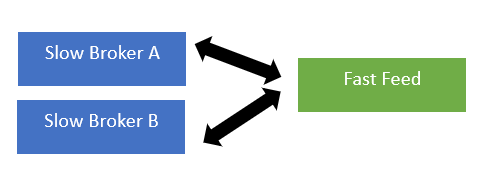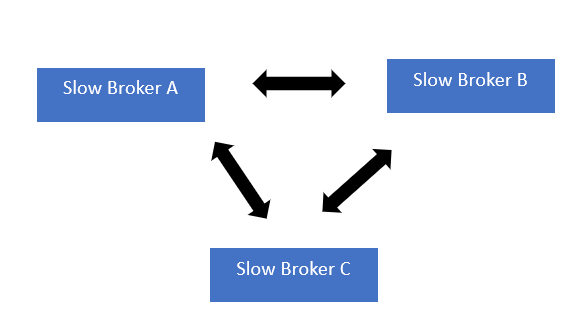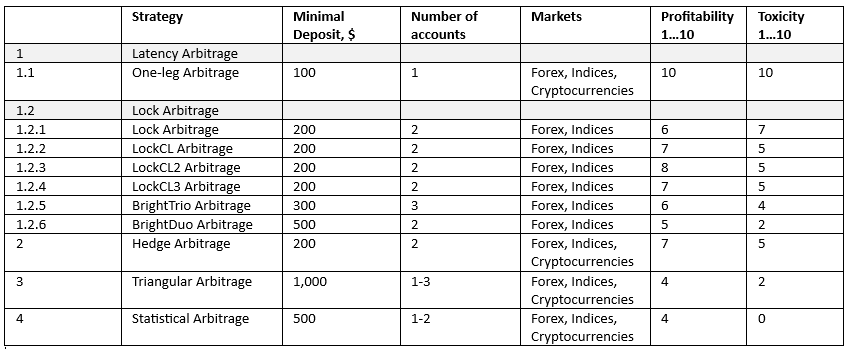차익거래의 세계 탐색하기: 레이턴시, 락, 헤지, 삼각, 통계적 차익거래 – 나에게 가장 적합한 전략을 선택하기 위한 종합 가이드 6월 15, 2023 – Posted in: Arbitrage Software, cryptoarbitrage software, Forex trading
차익거래(Arbitrage)란 프랑스어 arbitrer(판단하다)에서 유래한 용어로, 서로 다른 시장 간의 가격 불균형을 이용해 동일한 자산을 동시에 매수·매도하여 수익을 창출하는 거래 방식을 의미합니다. 이러한 가격 차이는 수요와 공급의 불균형, 지정학·지경학적 요인, 정보 전달의 차이 등으로 인해 발생합니다. 모든 차익거래 전략의 목적은 이러한 가격 괴리를 활용하는 데 있지만, 그 방법은 전략마다 크게 다릅니다.
이제 차익거래의 세계를 살펴보며 레이턴시(Latency), 락(Lock), 헤지(Hedge), 삼각(Triangular), 통계적(Statistical) 차익거래라는 다섯 가지 주요 유형을 알아보겠습니다. 각 전략은 고유한 장점과 도전 과제를 가지고 있으며, 자신의 리스크 허용도, 기술 수준, 투자 목표에 맞는 전략을 선택하는 것이 핵심입니다.
레이턴시 차익거래 (Latency Arbitrage)
1.1 원-레그 차익거래 전략 (One-Leg Arbitrage)
원-레그 차익거래는 주로 초고빈도 거래(HFT)에서 정보 전달 지연(레이턴시)을 이용하는 전략입니다. 트레이더는 고급 기술을 활용해 시장 간 가격 정보가 지연되는 순간을 포착하고 수익을 냅니다. 빠르고 큰 수익을 기대할 수 있지만, 고가의 기술 인프라가 필요하며 HFT 업체 간 경쟁이 매우 치열합니다.
이 전략에서 차익거래 소프트웨어는 일반적으로 ‘슬로우 계정’이라 불리는 거래 계정의 시세와 ‘패스트 피드’라 불리는 빠른 시세 공급원을 비교합니다. 패스트 피드의 가격이 계정 가격보다 먼저 움직이면 슬로우 계정에서 매수 주문을 실행하고, 반대의 경우에는 매도 주문을 실행합니다.

충분한 자본, 높은 기술적 전문성, 그리고 높은 리스크 감내도가 있다면 레이턴시 차익거래는 적합한 선택이 될 수 있습니다.
1.2 락 차익거래 (Lock Arbitrage)
락 차익거래 역시 레이턴시 차익거래의 한 형태로, 패스트 피드의 시세를 두 개의 슬로우 계정과 비교합니다. 헤지 또는 ‘락’을 통해 수익을 가능한 한 오래 유지하는 것이 목표입니다.
락 차익거래는 동일한 금융 상품을 서로 다른 시장에서 동시에 매수·매도하여 가격 차이로부터 확정적인 수익을 확보하는 방식입니다. 두 거래가 서로 상쇄되므로 상대적으로 리스크가 낮지만, 지속적인 모니터링이 필요하며 체결 실패와 같은 실행 리스크가 존재합니다.

1.2.1 락 차익거래 전략
이 전략은 가장 짧은 시간 또는 가장 작은 핍(pip) 차이로 수익을 고정하도록 설계되었습니다. 서로 다른 두 계정에서 동일한 종목에 대해 매수와 매도 주문을 동시에 설정하며, 차익거래 기회가 발생하면 포지션을 조정해 수익을 락인합니다.
1.2.2 LockCL 차익거래 전략
LockCL 전략은 거래를 완전히 종료하지 않고 동일한 계정 내에서 수익을 확보할 수 있도록 합니다. 가상 주문을 사용해 다음 차익거래 기회를 기다립니다.
1.2.3 LockCL2 차익거래 전략
LockCL2는 LockCL과 유사하지만, 조건 충족 후 포지션을 재개하는 방식이 다릅니다.
1.2.4 LockCL3 차익거래 전략
이 전략은 한 계정에서만 차익거래를 수행하고, 다른 계정은 락 용도로만 사용하도록 설계되었습니다.
1.2.5 BrightTrio 차익거래 전략
BrightTrio는 세 개의 계정(A, B, C)을 활용하여 차익거래를 수행하면서 거래 흔적을 효과적으로 숨기고 수익을 극대화하도록 설계된 고급 전략입니다.
1.2.6 BrightDuo 차익거래 전략
BrightDuo 전략은 매우 복잡한 알고리즘을 기반으로 하며, 자세한 내용은 이 글에서 확인할 수 있습니다.
보다 보수적인 투자 성향을 가지고 있고 시장을 지속적으로 모니터링할 수 있다면, 락 차익거래가 적합할 수 있습니다.
헤지 차익거래 전략 (Hedge Arbitrage)
헤지 차익거래(페어 트레이딩)는 한 자산을 매수하고, 이에 연관된 다른 자산을 매도하는 전략입니다. 통계적 상관관계를 기반으로 괴리를 활용하며, 한 포지션의 손실을 다른 포지션의 수익으로 상쇄할 수 있어 리스크가 비교적 낮습니다.

통계 분석에 대한 이해가 있고 중간 수준의 리스크를 감수할 수 있다면, 헤지 차익거래는 좋은 선택이 될 수 있습니다.
삼각 차익거래 전략 (Triangular Arbitrage)
삼각 차익거래는 세 가지 서로 다른 통화를 세 개의 시장에서 거래하며 환율 불균형을 이용해 수익을 창출하는 전략입니다. 매우 복잡하고 지속적인 환율 모니터링이 필요하며, 주로 알고리즘 거래 시스템을 통해 실행됩니다.

외환 시장에 대한 깊은 이해와 알고리즘 거래 인프라를 갖추고 있다면, 삼각 차익거래는 적합한 전략이 될 수 있습니다.
통계적 차익거래 전략 (Statistical Arbitrage)
통계적 차익거래는 수학적 모델을 활용해 거래 기회를 식별하는 전략입니다. 과거 가격 데이터와 다양한 시장 요인을 분석해 가격 움직임을 예측하며, 높은 수익 잠재력을 지니지만 고급 정량 분석 역량이 요구됩니다.
결론
적합한 차익거래 전략의 선택은 재무 목표, 리스크 허용도, 그리고 개인의 역량에 따라 달라집니다. 각 전략은 서로 다른 리스크-수익 구조와 기술적 요구 사항을 가지고 있습니다.
SharpTrader™ 소개: 최첨단 트레이딩을 위한 궁극의 차익거래 소프트웨어
SharpTrader™는 다양한 차익거래 전략과 초고속 실행 능력을 통해 시장 비효율성을 정교하게 활용할 수 있도록 설계된 강력한 플랫폼입니다. 초보자부터 전문가까지 모두에게 효율성, 다양성, 경쟁 우위를 제공합니다.
 English
English Deutsch
Deutsch 日本語
日本語 العربية
العربية Español
Español Português
Português Indonesia
Indonesia Tiếng Việt
Tiếng Việt 中文
中文


